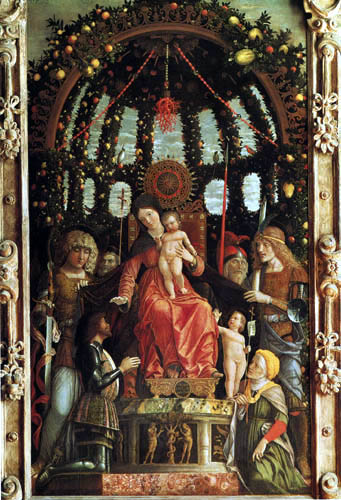Today, Holy Mother Church celebrates the Feast of Our Lady of the Rosary, or Our Lady of Victory. As posted earlier in the week, this feast commemorates Our Lady under the title of Our Lady of the Rosary, but also serves to mark the anniversary of the glorious victory of western Christendom over the invading Ottoman Turks at the Battle of Lepanto.
It is true that the Rosary is probably the single most identifiable mark of a Catholic. For Catholics, it is a devotion steeped in tradition as we meditate on the great mysteries of the life of Christ and His Blessed Mother. For non-Catholics, it is often seen as a stumbling block or a point of ridicule, used by some polemicists to attack the Church as being nothing more than a Marian cult or a medieval relic.
The history of the Rosary is, in itself, something that few people take the time to learn. I post below a brief history of the Holy Rosary, as found at PersonalizedRosaries.com:
The traditional story of the rosary was that Mary herself appeared to Saint Dominic in the twelfth century. At that time, tradition says she gave him the rosary and promised Dominic that if he spread devotion to the rosary, his religious order would flourish. It is quite true that Dominic was quite devoted to the Blessed Mother, but no one knows for sure if Our Lady herself gave Dominic the rosary. If she did, it is quite certain that she did not give him a rosary that looks like the one we have today.
Originally the rosary had 150 beads, the same number of psalms in the Bible. In the twelfth century, religious orders recited together the 150 Psalms as a way to mark the hours of the day and the days of the week. Those people who didn’t know how to read wanted to share in this practice, so praying on a string of 150 beads or knots began as a parallel to praying the psalms. It was a way that the illiterate could remember the Lord and his mother throughout the day. The “Divine Office”; the official prayer of the church; is the recitation of the psalms over a four week period, and is still prayed today.
 |
| Mantegna's "Madonna della Vittoria" |
This first rosary was prayed as we do today, a person would pass their fingers over each bead and say a prayer, usually the “Our Father”. The “Hail Mary” as we know it wasn’t even around at that time.
The Hail Mary owes its origin to the rosary. When people said the rosary in the twelfth century, Gabrielle’s greeting “Hail Mary, full or grace, the Lord is with thee” was often said along with the Our Father. Later, Elizabeth’s greeting ”blessed are you among women” was added. It was not until the sixteenth century that the words “Holy Mary., Mother of God, pray for us sinners now and at the hour of our death” were added.
Various people have added other things to the rosary over the centuries. In the fifteenth century, a Carthusian monk divided the rosary into fifteen brackets (or decades) and a Dominican assigned mysteries to each of the decades. These mysteries were events in the life of Jesus as written in the gospels. By meditating on these events even the illiterate could know the stories in the Bible. These decades were the same as ours except for the last two Glorious mysteries. In those two, the Coronation and the Assumption together made up the fourteenth decade and the fifteenth decade was the Last Judgment...
Despite all the additions and changes, the important core of the rosary has always remained the same. It is a way for God’s people to make holy the day, and to remember the life of Jesus and his mother. May these humble origins always be with us each time we pray the rosary.On this special day in honor of Our Lady, take the time to pray the Rosary, and to thank Our Lady for the manifold graces of God that she wins for us on a daily basis by her unceasing intercession for humanity.
For those who want a beautiful spiritual reflection on Our Lady of the Rosary, check out Word on Fire.
And for those who don't know how to pray the Rosary and would like to learn, here's a guide for you from The Rosary Confraternity, run by the Dominican Friars.
Our Lady of the Rosary, pray for us!
Our Lady of Victory, pray for us!


No comments:
Post a Comment